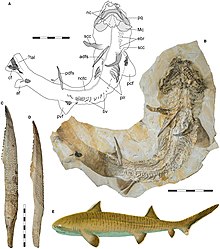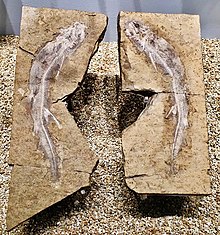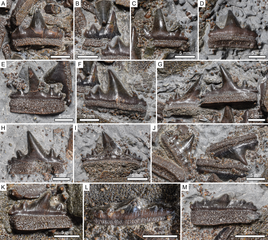Hybodontiformes
| Hybodontiformes Temporal range:LateDevoniantoLate Cretaceous
| |
|---|---|

| |
| Fossil and life restoration ofAsteracanthus,from the Late Jurassic of Europe | |
| Scientific classification | |
| Domain: | Eukaryota |
| Kingdom: | Animalia |
| Phylum: | Chordata |
| Class: | Chondrichthyes |
| Subclass: | Elasmobranchii |
| Infraclass: | Euselachii |
| Order: | †Hybodontiformes Patterson, 1966 |
| Families | |
|
See text | |
Hybodontiformes,commonly calledhybodonts,are anextinctgroup of shark-likecartilaginous fish(chondrichthyans) which existed from the lateDevonianto theLate Cretaceous.Hybodonts share a close common ancestry with modernsharksandrays(Neoselachii) as part of the cladeEuselachii.They are distinguished from other chondrichthyans by their distinctive fin spines and cephalic spines present on the heads of males. An ecologically diverse group, they were abundant in marine and freshwater environments during the latePaleozoicand earlyMesozoic,but were rare in open marine environments by the end of theJurassic,having been largely replaced by modern sharks, though they were still common in freshwater and marginal marine habitats. They survived until the end of theCretaceous,before going extinct.
Etymology
[edit]The term hybodont comes from the Greek wordὕβοςorὑβόςmeaning hump or hump-backed andὀδούς, ὀδοντmeaning tooth. This name was given based on their conical compressed teeth.
Taxonomic history
[edit]Hybodonts were first described in the nineteenth century based on isolated fossil teeth (Agassiz,1837). Hybodonts were first separated from livingsharksby Zittel (1911).[1]Although historically argued to have a close relationship with the modern shark orderHeterodontiformes,this has been refuted.[2]Hybodontiformes aretotal group-elasmobranchsand thesister grouptoNeoselachii,which includes modern sharks andrays.Hybodontiformes and Neoselachii are grouped together in the clade Euselachii, to the exclusion of other total-group elasmobranchs likeXenacanthiformes.[3]Hybodonts are divided into a number of families, but the higher level taxonomy of hybodonts, especiallyMesozoictaxa, is poorly resolved.[4]
Description
[edit]
The largest hybodonts reached lengths of 2–3 metres (6.6–9.8 ft),[4]while some other hybodonts were much smaller, with adult body lengths of around 25 centimetres (0.82 ft).[5]Hybodonts had a generally robust bodyform. Due to theircartilaginousskeletons usually disintegrating upon death like otherchondrichthyans,hybodonts are generally described and identified based on teeth and fin spine fossils, which are more likely to be preserved.[4]Rare partial or complete skeletons are known from areas ofexceptional preservation.[6][4][7]

Hybodonts are recognized as having teeth with a prominent cusp which is higher than lateral cusplets.[8]Hybodont teeth are often preserved as incomplete fossils because the base of the tooth is not well attached to the crown.[8]Hybodonts were initially divided into two groups based on their tooth shape.[9]One group had teeth with acuminate cusps that lacked a pulp cavity; these are called osteodont teeth. The other group had a different cusp arrangement and had a pulp cavity, these are called orthodont teeth.[10]For example, the hybodont speciesHeterophychodus steinmannihave osteodont teeth with vascular canals of dentine which are arranged vertically parallel to each other, also called ‘tubular dentine’.[11]The crowns of these osteodont teeth are covered with a single layer ofenameloid.Hybodont teeth served a variety of functions depending on the species, including grinding, crushing (durophagy), tearing, clutching, and even cutting.[4]
Hybodonts are characterized by having two dorsal fins each preceded by a fin spine. The fin spine morphology is unique to each hybodont species. The fin spines are elongate and gently curved towards the rear, with the posterior part of the spine being covered in hooked denticles, typically in two parallel rows running along the length of the spine, sometimes with a ridge between them. Part of the front of the spines are often covered in a ribbed ornamentation, while in some other hybodonts this region is covered in rows of small bumps. The spines are mineralised, and primary composed ofosteodentine,while the ornamentation is formed of enamel.[12]Similar fin spines are also found in many extinct chondrichthyan groups as well as in some modern sharks likeHeterodontusandsqualids.[13]Male hybodonts had either one or two pairs of cephalic spines on their heads, a characteristic distinctive to hybodonts.[14]These spines, while of variable placement,[10]were always placed posterior to the eye socket,[15]and were composed of a base divided into three lobes, with the main part of the spine being backwardly curved, most specimens of which had a barb near the apex.[10]These spines, like the fin spines, were mineralised, with the base composed of osteodentine,[16]while the main part of the spine was covered in enamel. Male hybodonts possessed finclaspersused in mating, like modern sharks.[10]Hybodonts had a fullyheterocercaltail fin, where the upper lobe of the fin was much larger than the lower one due to the spine extending into it.[17]Like living sharks and rays, the skin of hybodonts was covered withdermal denticles.[18]Hybodonts laidegg cases,similar to those produced by living cartilaginous fish. Most hybodont egg cases are assigned to the genusPalaeoxyris,which tapers towards both ends, with one end having a tendril which attached to substrate, with the middle section being composed of at least three twisted bands.[19]
-
Teeth ofDurnovariaodus,a member of the familyHybodontidae
-
Jaw fragment ofStrophodusa specialised durophagous hybodont
-
Jaws ofAsteracanthus,showing the arrangement of the teeth in jaws. The teeth were designed for grasping
-
Teeth ofPlanohybodus,a hybodontid, whose teeth were designed for tearing
Ecology
[edit]
Hybodont fossils are found in depositional environments ranging from marine tofluvial(river deposits).[20]Many hybodonts are thought to have beeneuryhaline,able to tolerate a wide range of salinities.[21]Hybodonts inhabited freshwater environments from early in their evolutionary history, spanning from the Carboniferous onwards.[22]Based on isotopic analysis, some species of hybodonts are likely to have permanently lived in freshwater environments,[23][24]while others may have migrated between marine and freshwater environments.[25]One genus of hybodont,Onychoselacheof the lowerCarboniferousof Scotland, is suggested to have been capable of amphibious locomotion, similar to modernorectolobiformsharks such as bamboo and epaulette sharks, due to its well-developed pectoral fins.[16]It has been suggested that male hybodonts used their cephalic spines to grip females during mating.[26]Preservedegg casesof hybodonts assigned toPalaeoxyrisindicate that at least some hybodonts laid their eggs in freshwater and brackish environments, with the eggs being attached to vegetation via a tendril. Laying of eggs in freshwater is not known in any living cartilaginous fish.[27][19][28]At least some hybodonts are suggested to have utlilized specific sites as nurseries, such as in the Triassic lake deposits of theMadygen Formationof Kyrgyzstan, where eggs ofLonchidionare suggested to have been laid on the lakeshore or upriver areas, where the juveniles hatched and matured, before migrating deeper into the lake as adults.[27]

Some hybodonts likeHybodusare thought to have been active predators capable of feeding on swiftly moving prey,[2]with preserved stomach contents of a specimen ofHybodus hauffianusindicating that they fed onbelemnites.[29]Hybodonts have a wide variety of tooth shapes. This variety suggests that they took advantage of multiple food sources.[8]It is thought that some hybodonts which had wider, flatter, teeth specialized in crushing or grinding hard-shelled prey (durophagy).[20]Often multiple species of hybodonts with different prey preferences coexisted within the same ecosystem.[30][11]
Evolutionary history
[edit]
The earliest hybodont remains are from the latestDevonian(Famennian) of Iran, belonging to the genusRoongodus,[31]as well as remains assigned toLissodusof the same age from Belgium.[32]Although the first fossils of hybodonts are from the latest Devonian, they likely branched off from neoselachians (modern sharks) during the early Devonian.[33]Carboniferous hybodonts include both durophagous and non-durophagous forms, while durophagous forms were dominant during the Permian period.[32]By the Permian period, hybodonts had a global distribution.[32][34][35]ThePermian-Triassic extinction eventonly had a limited effect on hybodont diversity.[36]Maximum hybodont diversity is observed during the Triassic. During the Triassic and Early Jurassic, hybodontiforms were the dominant elasmobranchs in both marine and non-marine environments.[20]A shift in hybodonts was seen during the Middle Jurassic, a transition between the distinctly different assemblages seen in the Triassic – Early Jurassic and the Late Jurassic – Cretaceous.[20]As neoselachians (group of modern sharks) diversified further during the Late Jurassic, hybodontiforms became less prevalent in open marine conditions but remained diverse in fluvial and restricted settings during the Cretaceous.[20]By the end of the Cretaceous, hybodonts had declined to only a handful of species,[37]including members ofLonchidion[38],andMeristodonoides.[39]The last hybodonts disappeared, seemingly abruptly, as part of theCretaceous-Paleogene extinction event.[37]
Families and genera
[edit]The taxonomy of hybodonts is considered poorly resolved,[4]so the classification presented should not be taken as authoritative.
- Lonchidiidae Herman, 1977[40]
- Distobatidae
- Acrodontidae
- Hybodontidae
- Incertae sedis
- Tribodus
- Strophodus
- Asteracanthus
- Roongodus
- Polyacrodus
- Palaeobates
- Bdellodus
- Thaiodus
- Acrorhizodus
- Khoratodus
- Arctacanthus
- Reesodus
- Steinbachodus
- Onychoselache
- Omanoselache
- Pororhiza
- Mukdahanodus
- Secarodus
- Hamiltonichthys
- Gansuselache
- Dabasacanthus
- Teresodus
- Diablodontus
- Gunnellodus?
- Heteroptychodus
- Lissodus
- Columnaodus
- Form genera
- Palaeoxyris(genus used for the egg capsules of hybodonts)
References
[edit]- ^Zittel, K. von, 1911, Grunzuege der Palaontologie, 2 ed. II. Abt. Vertebrata, vii + 598 pp. R. Oldenburg Verlag, Muchen, Berlin.
- ^abMaisey, J. G., 2012, What is an ‘elasmobranch’? The impact of palaeontology in understanding elasmobranch phylogeny and evolution: Journal of Fish Biology, v. 80, no. 5, p. 918-951.
- ^Coates, Michael I.; Tietjen, Kristen (March 2017)."The neurocranium of the Lower Carboniferous shark Tristychius arcuatus (Agassiz, )".Earth and Environmental Science Transactions of the Royal Society of Edinburgh.108(1): 19–35.Bibcode:2017EESTR.108...19C.doi:10.1017/S1755691018000130.ISSN1755-6910.S2CID135297534.
- ^abcdefStumpf, Sebastian; López-Romero, Faviel A.; Kindlimann, René; Lacombat, Frederic; Pohl, Burkhard; Kriwet, Jürgen (August 2021). Cavin, Lionel (ed.)."A unique hybodontiform skeleton provides novel insights into Mesozoic chondrichthyan life".Papers in Palaeontology.7(3): 1479–1505.Bibcode:2021PPal....7.1479S.doi:10.1002/spp2.1350.ISSN2056-2799.S2CID234204226.
- ^Vullo, Romain; Néraudeau, Didier; Dépré, Eric (October 2013)."Vertebrate remains from the Cenomanian (Late Cretaceous) plant-bearing Lagerstätte of Puy-Puy (Charente-Maritime, France)".Cretaceous Research.45:314–320.Bibcode:2013CrRes..45..314V.doi:10.1016/j.cretres.2013.06.002.
- ^Lane, J. A., and Maisey, J. G., 2009, Pectoral Anatomy of Tribodus limae (Elasmobranchii: Hybodontiformes) from the Lower Cretaceous of Northeastern Brazil: Journal of Vertebrate Paleontology, v. 29, no. 1, p. 25-38.
- ^Wang, N.-Z.; Zhang, X.; Zhu, M.; Zhao, W.-J. (May 2009)."A new articulated hybodontoid from Late Permian of northwestern China".Acta Zoologica.90:159–170.doi:10.1111/j.1463-6395.2008.00382.x.
- ^abcKoot, M. B., Cuny, G., Tintori, A., and Twitchett, R. J., 2013, A new diverse shark fauna from the Wordian (Middle Permian) Khuff Formation in the interior Haushi-Huqf area, Sultanate of Oman: Palaeontology, v. 56, no. 2, p. 303-343.
- ^Agassiz, L., 1833-1844, Recherches sur les poisons fossils. Neuchatel, 5 vols. 1420 pp. with supplement.
- ^abcdMaisey, J. G., 1982,The anatomy and interrelationships of Mesozoic hybodont sharks:American Museum Novitates, v. 2724.
- ^abCuny, G., Suteethorn, V., Buffetaut, E., and Philippe, M., 2003, Hybodont sharks from the Mesozoic Khorat Group of Thailand: Mahasarakham University Journal, v. 22.
- ^Maisey, J. G., 1978,Growth and form of spines in hybodont sharks:Palaeontology, v. 21, no. 3, p. 657-666.
- ^Maisey, John G. (2009-03-12)."The spine-brush complex in symmoriiform sharks (Chondrichthyes; Symmoriiformes), with comments on dorsal fin modularity".Journal of Vertebrate Paleontology.29(1): 14–24.Bibcode:2009JVPal..29...14M.doi:10.1671/039.029.0130.ISSN0272-4634.S2CID86408226.
- ^Rees, Jan (March 2002)."Shark fauna and depositional environment of the earliest Cretaceous Vitabäck Clays at Eriksdal, southern Sweden".Earth and Environmental Science Transactions of the Royal Society of Edinburgh.93(1): 59–71.doi:10.1017/S0263593300000328.ISSN1473-7116.S2CID130984933.
- ^Stumpf, Sebastian; Etches, Steve; Underwood, Charlie J.; Kriwet, Jürgen (2021-05-11)."Durnonovariaodus maiseyi gen. et sp. nov., a new hybodontiform shark-like chondrichthyan from the Upper Jurassic Kimmeridge Clay Formation of England".PeerJ.9:e11362.doi:10.7717/peerj.11362.ISSN2167-8359.PMC8121075.PMID34026354.
- ^abCoates, Michael I.; Gess, Robert W. (2007)."A New Reconstruction of Onychoselache Traquairi, Comments on Early Chondrichthyan Pectoral Girdles and Hybodontiform Phylogeny".Palaeontology.50(6): 1421–1446.Bibcode:2007Palgy..50.1421C.doi:10.1111/j.1475-4983.2007.00719.x.S2CID140556654.
- ^Kim, Sun H.; Shimada, Kenshu; Rigsby, Cynthia K. (March 2013)."Anatomy and Evolution of Heterocercal Tail in Lamniform Sharks: CAUDAL FINS OF LAMNIFORM SHARKS".The Anatomical Record.296(3): 433–442.doi:10.1002/ar.22647.PMID23381874.S2CID205411092.
- ^Maisey, John G.; Denton, John S. S. (2016-09-02)."Dermal denticle patterning in the Cretaceous hybodont shark Tribodus limae (Euselachii, Hybodontiformes), and its implications for the evolution of patterning in the chondrichthyan dermal skeleton".Journal of Vertebrate Paleontology.36(5): e1179200.Bibcode:2016JVPal..36E9200M.doi:10.1080/02724634.2016.1179200.ISSN0272-4634.S2CID88591830.
- ^abFischer, Jan; Axsmith, Brian J.; Ash, Sidney R. (2010-03-01)."First unequivocal record of the hybodont shark egg capsule Palaeoxyris in the Mesozoic of North America".Neues Jahrbuch für Geologie und Paläontologie - Abhandlungen.255(3): 327–344.doi:10.1127/0077-7749/2009/0028.ISSN0077-7749.
- ^abcdeRees, J. A. N., and Underwood, C. J., 2008, Hybodont sharks of the English Bathonian and Callovian (Middle Jurassic): Palaeontology, v. 51, no. 1, p. 117-147.
- ^Batchelor, Trevor John (December 2013)."A new species of Vectiselachos (Chondrichthyes, Selachii) from the Early Cretaceous of southern England".Proceedings of the Geologists' Association.124(6): 967–972.Bibcode:2013PrGA..124..967B.doi:10.1016/j.pgeola.2013.05.001.
- ^Wen, Wen; Kriwet, JüRgen; Zhang, Qiyue; Benton, Michael J.; Duffin, Christopher J.; Huang, Jingyuan; Zhou, Changyong; Hu, Shixue; Ma, Zhixin (2022-06-30)."Hybodontiform shark remains (Chondrichthyes, Elasmobranchii) from the Lower Triassic of Yunnan Province, China, with comments on hybodontiform diversity across the PTB".Journal of Vertebrate Paleontology.42(1).Bibcode:2022JVPal..42E8712W.doi:10.1080/02724634.2022.2108712.ISSN0272-4634.S2CID252136919.
- ^Fischer, Jan; Schneider, Jörg W.; Voigt, Silke; Joachimski, Michael M.; Tichomirowa, Marion; Tütken, Thomas; Götze, Jens; Berner, Ulrich (2013-03-29)."Oxygen and strontium isotopes from fossil shark teeth: Environmental and ecological implications for Late Palaeozoic European basins".Chemical Geology.342:44–62.Bibcode:2013ChGeo.342...44F.doi:10.1016/j.chemgeo.2013.01.022.ISSN0009-2541.
- ^Klug, Stefanie; Tütken, Thomas; Wings, Oliver; Pfretzschner, Hans-Ulrich; Martin, Thomas (2010-09-01)."A Late Jurassic freshwater shark assemblage (Chondrichthyes, Hybodontiformes) from the southern Junggar Basin, Xin gian g, Northwest China".Palaeobiodiversity and Palaeoenvironments.90(3): 241–257.Bibcode:2010PdPe...90..241K.doi:10.1007/s12549-010-0032-2.ISSN1867-1608.S2CID129236098.
- ^Leuzinger, L.; Kocsis, L.; Billon-Bruyat, J.-P.; Spezzaferri, S.; Vennemann, T. (2015-12-07)."Stable isotope study of a new chondrichthyan fauna (Kimmeridgian, Porrentruy, Swiss Jura): an unusual freshwater-influenced isotopic composition for the hybodont shark <i>Asteracanthus</i>".Biogeosciences.12(23): 6945–6954.Bibcode:2015BGeo...12.6945L.doi:10.5194/bg-12-6945-2015.hdl:11336/80921.ISSN1726-4189.S2CID129044300.
- ^Turmine-Juhel, Pernelle; Wilks, Richard; Brockhurst, David; Austen, Peter A.; Duffin, Christopher J.; Benton, Michael J. (December 2019)."Microvertebrates from the Wadhurst Clay Formation (Lower Cretaceous) of Ashdown Brickworks, East Sussex, UK".Proceedings of the Geologists' Association.130(6): 752–769.Bibcode:2019PrGA..130..752T.doi:10.1016/j.pgeola.2019.08.003.S2CID202904040.
- ^abFischer, J. A. N., Voigt, S., Schneider, J. W., Buchwitz, M., and Voigt, S., 2011, A selachian freshwater fauna from the Triassic of Kyrgyzstan and its implication for Mesozoic shark nurseries: Journal of Vertebrate Paleontology, v. 31, no. 5, p. 937-953.
- ^Krüger, Ashley; Slater, Sam; Vajda, Vivi (2021-07-03)."3D imaging of shark egg cases ( Palaeoxyris ) from Sweden with new insights into Early Jurassic shark ecology".GFF.143(2–3): 229–247.Bibcode:2021GFF...143..229K.doi:10.1080/11035897.2021.1907442.ISSN1103-5897.
- ^Klug, Christian; Schweigert, Günter; Hoffmann, René; Weis, Robert; De Baets, Kenneth (December 2021)."Fossilized leftover falls as sources of palaeoecological data: a 'pabulite' comprising a crustacean, a belemnite and a vertebrate from the Early Jurassic Posidonia Shale".Swiss Journal of Palaeontology.140(1): 10.Bibcode:2021SwJP..140...10K.doi:10.1186/s13358-021-00225-z.ISSN1664-2376.PMC8549986.PMID34721282.
- ^Cappetta, H., Buffetaut, E., Cuny, G., and Suteethorn, V., 2006, A new Elasmobranch assemblage from the Lower Cretaceous of Thailand Palaeontology, v. 49, no. 3, p. 547-555.
- ^Hairapetian, V. and Ginter, M. 2009. Famennian chondrichthyan remains from the Chahriseh section, central Iran. Acta Geologica Polonica, 59, 173–200.
- ^abcHodnett, J-P., Elliott, D. K., and Olson, T. J. 2013. A new basal hybodont (Chondrichthyes, Hybodontiformes) from the Middle Permian (Roadian) Kaibab Formation, of northern Arizona. New Mexico Museum of Natural History and Science Bulletin, 60:103–108.
- ^Coates, M. I., and Gess, R. W., 2007, A new reconstruction of Onychoselache Traquairi, comments on early Chondrichthyan pectoral girdles and hybodontiform phylogeny: Palaeontology, v. 50, no. 6, p. 1421-1446.
- ^Peecook, Brandon R.; Bronson, Allison W.; Otoo, Benjamin K.A.; Sidor, Christian A. (November 2021)."Freshwater fish faunas from two Permian rift valleys of Zambia, novel additions to the ichthyofauna of southern Pangea".Journal of African Earth Sciences.183:104325.Bibcode:2021JAfES.18304325P.doi:10.1016/j.jafrearsci.2021.104325.
- ^Cione, Alberto Luis; Gouiric-Cavalli, Soledad; Mennucci, Jorge Augusto; Cabrera, Daniel Alfredo; Freije, Rubén Hugo (2010)."First vertebrate body remains from the Permian of Argentina (Elasmobranchii and Actinopterygii)".Proceedings of the Geologists' Association.121(3): 301–312.Bibcode:2010PrGA..121..301C.doi:10.1016/j.pgeola.2010.04.003.
- ^Wen, Wen; Zhang, Qiyue; Benton, Michael J.; Kriwet, Jürgen; Hu, Shixue; Huang, Jinyuan; Zhou, Changyong; Cui, Xindong; Ma, Zhixin; Min, Xiao (February 2023)."First occurrence of hybodontid teeth in the Luoping Biota (Middle Triassic, Anisian), emphasizing recovery of the marine ecosystem after the end-Permian mass extinction".Palaeogeography, Palaeoclimatology, Palaeoecology.617:111471.doi:10.1016/j.palaeo.2023.111471.
- ^abKriwet, Jürgen; Benton, Michael J. (November 2004)."Neoselachian (Chondrichthyes, Elasmobranchii) diversity across the Cretaceous–Tertiary boundary".Palaeogeography, Palaeoclimatology, Palaeoecology.214(3): 181–194.doi:10.1016/j.palaeo.2004.02.049.
- ^Gates, Terry A.; Gorscak, Eric; Makovicky, Peter J. (May 2019)."New sharks and other chondrichthyans from the latest Maastrichtian (Late Cretaceous) of North America".Journal of Paleontology.93(3): 512–530.Bibcode:2019JPal...93..512G.doi:10.1017/jpa.2018.92.ISSN0022-3360.
- ^Stumpf, Sebastian; Meng, Stefan; Kriwet, Jürgen (2022-01-26)."Diversity Patterns of Late Jurassic Chondrichthyans: New Insights from a Historically Collected Hybodontiform Tooth Assemblage from Poland".Diversity.14(2): 85.doi:10.3390/d14020085.ISSN1424-2818.
- ^Manzanares, Esther; Pla, Cristina; Martínez-Pérez, Carlos; Ferrón, Humberto; Botella, Héctor (2017-01-02)."Lonchidion derenzii, sp. nov., a new lonchidiid shark (Chondrichthyes, Hybodontiforms) from the Upper Triassic of Spain, with remarks on lonchidiid enameloid".Journal of Vertebrate Paleontology.37(1): e1253585.Bibcode:2017JVPal..37E3585M.doi:10.1080/02724634.2017.1253585.hdl:10550/85565.ISSN0272-4634.S2CID132467956.
- Hybodontiformes
- Prehistoric cartilaginous fish orders
- Carboniferous first appearances
- Pennsylvanian taxonomic orders
- Cisuralian taxonomic orders
- Guadalupian taxonomic orders
- Lopingian taxonomic orders
- Early Triassic taxonomic orders
- Middle Triassic taxonomic orders
- Late Triassic taxonomic orders
- Early Jurassic taxonomic orders
- Middle Jurassic taxonomic orders
- Late Jurassic taxonomic orders
- Early Cretaceous taxonomic orders
- Late Cretaceous taxonomic orders






